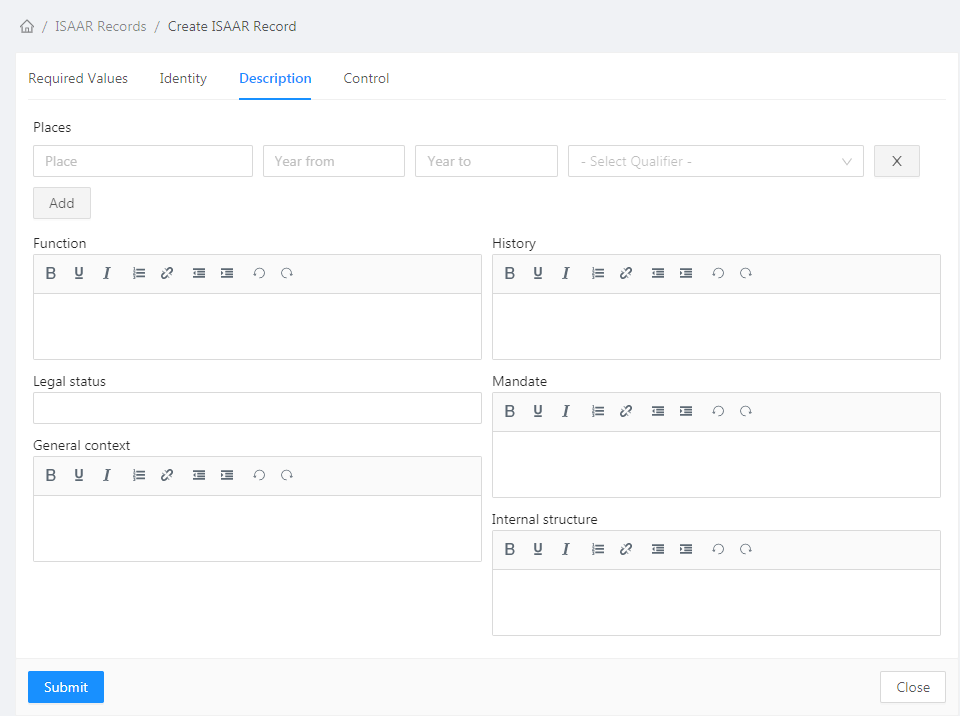Description Tab
The Description Tab contains essential contextual information on the entity being described by the authority record.

Places
Standard Reference: ISAAR 5.2.3 Format: Free text. Additional places of existence can be added to the ISAAR/CPF record by pressing the Add + button. Purpose: To indicate the predominant places and/or jurisdictions where the corporate body, person, or family was based, lived, or resided or had some other connection. Rule: Record the name of the predominant place(s)/jurisdiction(s), together with the nature and covering dates of the relationship with the entity. Example: Berlin, 1988 1991 [Select Qualifier]
Function
Standard Reference: ISAAR 5.2.5 Format: Free text. Purpose: To indicate the functions, occupations, and activities performed by the corporate body, person, or family. Rule: Record the functions, occupations, and activities performed by the entity being described, together with the covering dates when useful. If necessary, describe the nature of the function, occupation, or activity. Example: The Eagles are an American rock band that make music, tour, and sell records and Eagles merchandise.
History
Standard Reference: ISAAR 5.2.2 Format: Free text Purpose: To provide a concise history of the corporate body, person, or family. Rule: Record in narrative form or as a chronology the main life events, activities, achievements, and/or roles of the entity being described. This may include information on gender, nationality, family, and religious or political affiliations. Wherever possible, supply dates as an integral component of the narrative description. Example: The organization was established in 1950. During the first 12 years, it was subordinated to the Ministry of the Interior. After 1962 it was nominally independent and formally responsible for the parliament but in fact, the influence of the Ministry on the decisions was still significant. The profile of the organization slightly changed during the revolution in 1956 according to the demands of the regime, the membership of the body has significantly risen from 200 to 1000 in this short period.
Legal status
Standard Reference: ISAAR 5.2.4 Format: Free text Purpose: To indicate the legal status of a corporate body. Rule: Record the legal status and where appropriate the type of corporate body together with the covering dates when this status was applied. Example: Body of Open Society Foundations in Hungary. Note parent organization of OSI-Budapest)
Mandate
Standard Reference: ISAAR 5.2.6 Format: Free text Purpose: To indicate the sources of authority for the corporate body, person, or family in terms of its powers, functions, responsibilities, or sphere of activities, including territorial. Rule: Record any document, law, directive, or charter which acts as a source of authority for the powers, functions, and responsibilities of the entity being described, together with information on the jurisdiction(s) and covering dates when the mandate(s) applied or were changed. Example: Helsinki Final Act, 1975
General context
Standard Reference: ISAAR 5.2.8, Format:: Free text. Purpose: To provide significant information on the general social, cultural, economic, political, and/or historical context in which the corporate body, person, or family operated, lived, or was active. Rule: Provide any significant information on the social, cultural, economic, political, and/or historical context in which the entity being described operated. Example: After the conflict, the operation of this kind of group becomes practically impossible. Most of these activists were captured or persecuted and the security services of the new regime confiscated all the equipment to fulfill their mission. Despite these circumstances, a group of free activists decided to continue their mission.
Internal structure
Standard Reference: ISAAR 5.2.7, Format: Free text. Purpose: To describe and/or represent the internal administrative structure(s) of a corporate body or the genealogy of a family. Rule: Describe the internal structure of a corporate body and the dates of any changes to that structure that are significant to the understanding of the way that the corporate body conducted its affairs (e.g. using dated organization charts). Describe the genealogy of a family in a way that demonstrates the interrelationships of its members by covering dates. Example: The Texas Board of Criminal Justice (TBCJ) is comprised of nine non-salaried members who are appointed by the Governor for staggered six-year terms. Charged with governing the Texas Department of Criminal Justice (TDCJ), the TBCJ develops and implements policies that guide TDCJ’s operations. The TBCJ also serves as the school board for the Windham School District. Appointed by the TBCJ, the executive director is responsible for the day-to-day administration and operation of the TDCJ. The TDCJ is comprised of the following divisions: Administrative Review and Risk Management, Community Justice Assistance, Correctional Institutions, Facilities, General Counsel, Health Services, Human Resources, Information Technology, Manufacturing, and Logistics, Private Facility Contract Monitoring/Oversight, Parole, Rehabilitation Programs Division, and Victim Services. The departments within the Business and Finance Division report directly to the Chief Financial Officer. In August 2009, the Reentry and Integration Division was created. The division combines the Texas Correctional Office on Offenders with Medical or Mental Impairments (TCOOMMI), Project Re-Integration of Offenders (RIO), and an expanded reentry initiative, to better focus the state’s resources on reducing recidivism and addressing the needs of juvenile and adult offenders.
(source: https://www.tdcj.state.tx.us/org_chart/org_chart_narrative.html)

